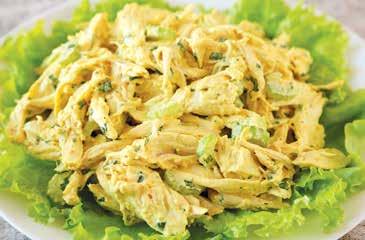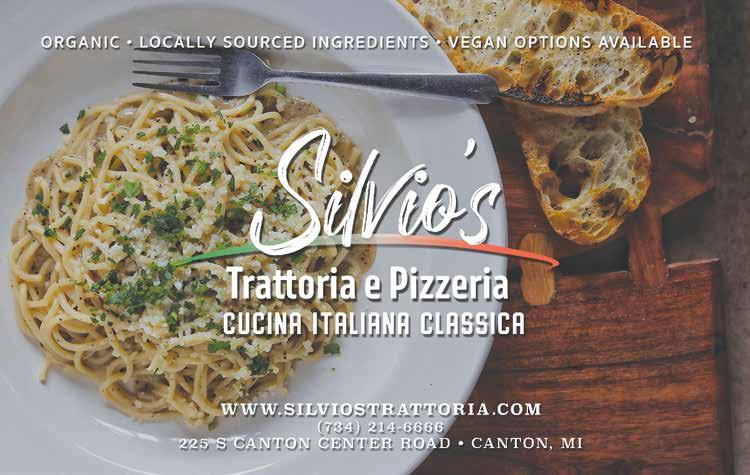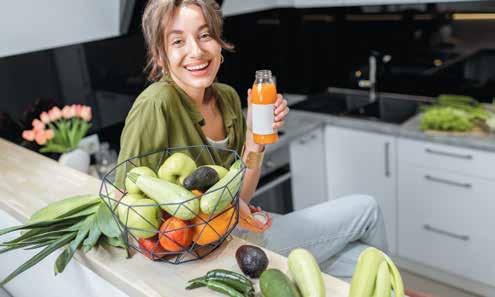
7 minute read
COOLING THE FIRE WITHIN
Healthy Eating Tips to Ease Chronic Inflammation
by Tom O’Bryan
Putting more thought into what we eat and why may be among the most important factors in determining how long we live. Researchers in Norway recently compared the long-term effects of a typical Western diet to an optimal one, and their findings can be a source for inspiration. The optimal diet had a substantially higher intake of whole grains, legumes, fish, fruits, vegetables and a handful of nuts, while reducing red and processed meats, sugar-sweetened beverages and refined grains.
According to their results, a sustained change from a typical Western diet to the better plan can make a big difference on life expectancy. Here are their predicted impacts on longevity for people after starting—and sticking to—an optimal diet: Start at age 20—women add 8.4 to 12.3 years; men add 9.4 to 14.3 years Start at age 60—women add 6.2 to 9.3 years; men add 6.8 to 10 years Start at age 80—women and men add 3.4 years So, it is never too late to start a positive activity.
This improved diet gets to the underlying causes of most of the reasons Americans die. According to the National Institutes of Health, 14 of the top 15 causes of death in 2019 were chronic inflammatory diseases. This means it is more than likely that the cause has existed for a long time under the surface (chronic), with too much inflammation for too long (inflammatory), affecting the brain, cardiovascular system, blood sugar system or wherever there is a genetic weak link (disease). Rather than ask what the ailment is, ask, “Where is the long-term, hidden inflammation coming from that is fueling this disease?”
Dr. George Slavich, founding director of the Laboratory for Stress Assessment and Research at the University of California in Los Angeles, says that understanding when inflammation promotes either good or poor health and how and when to intervene to reduce inflammation-related disease risk, “should be a top scientific and
TRAINING STARTS MARCH 3REGISTER NOW! Soul Power Mystic Arts
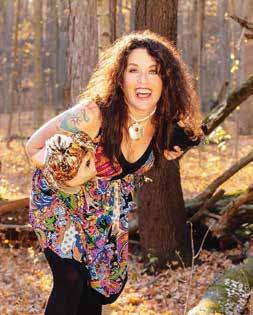
Cultivate the Nature Mystic Within and Awaken Deep Womb Wisdom
• Self Acceptance Process Healers Training • 4 Deep Dive Retreats • 9 Workshops Starts on March 3rd!
Learn more at MotherBearSanctuary.com and BarbraWhite.com
ONGOING w Jan. 14, Awaken to Your Soul Theme, 10-5pm, $250 Westland. w Jan. 17, Get Out of Stress fundraiser workshops for Inkster community projects. w Feb. 4, 10-5 Social Activists, Healers–Get Your Message Out–without burnout.
Nature Immersion, Qi-Cong. Donation to Sasha Farms.
For all events: e-mail motherbearbarbra@gmail.com or call 734-796-6690 to register.
public priority.” Identifying and reducing individual triggers of inflammation opens a path to regenerating a healthier, younger individual.
Not all inflammation is bad. Time-limited increases in inflammation are critical for promoting wound healing and recovery, as well as reducing the spread of communicable infections. Humans would not have lived very long without a well-developed internal protection from threatening environmental triggers such as bugs, parasites, viruses, mold, fungus and bacteria. For better health outcomes, we need to address excessive systemic inflammation. There are many likely contributors to the fueling of inflammation, but one of the most common sources is what is on the end of our fork. Begin there. LIFESTYLE HACK 1: If there is one prime directive for better health, it is to focus on living as much of an anti-inflammatory lifestyle as possible. Become more aware of the daily environmental exposures that ramp up inflammatory genes. Know, for example, what chemicals are used on the soil in which the food is grown or sprayed with before it is harvested. Then, armed with this knowledge, choose a better alternative, like organic and regenerative organic foods. As enough anti-inflammatory messages are accumulated, a reversal in the direction of health is possible. LIFESTYLE HACK 2: Food is the most common source of gasoline on the fire of inflammation. Dr. Deanna Minich, president of the American College of Nutrition, recommends the Rainbow Diet, which acts like a fire extinguisher to put out the excess inflammatory fire in the body. Selecting multiple colors of fruits and vegetables at every meal tempers the inflammatory cascade. Strive over time to eat 50 different fruits or vegetables per week. Begin today. Just bringing up to awareness the question, “Is this food inflammatory or anti-inflammatory?” will feed our health habits, and over time, healthier habits equal a healthier life.
KnoWEwell Chief Health Officer Dr. Tom O’Bryan, DC, CCN, DACBN, is an internationally recognized expert on gluten, bestselling author and speaker focused on food sensitivities, environmental toxins and the development of autoimmune diseases. He is a chiropractic doctor, certified clinical nutritionist and the founder of TheDr.com.
ZUCCHINI PASTA WITH SALMON AND ARTICHOKE
YIELD: 4 SERVINGS
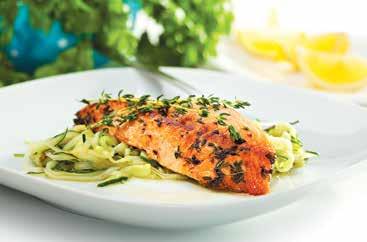
6 zucchinis, medium to large, firm and straight, cut into “noodles” 2 lb fresh, wild salmon fillets, skin removed Sea salt and pepper 2 Tbsp high-heat cooking oil (avocado or grapeseed) 3 Tbsp olive oil 4 Tbsp shallots, minced 4 cloves garlic, minced 8 artichoke hearts (in water), quartered 1 lemon, zested and juiced



Your Source For:
• Over 1,000 Homeopathic Remedies • Exclusive Nutritional Supplements • Herbs, Essential Oils & Flower Essences • Unique Books, Gifts, & Jewelry
Offering In-Store Shopping, Shipping, Contactless Pick Up
2345 S. Huron Parkway, Ann Arbor, MI (734) 973-8990 • CastleRemedies.com
4 Tbsp fresh parsley, chopped Pinch of cayenne 6 slices crumbled, crispy turkey bacon; crispy bacon; or crispy pancetta
Zucchini can be fashioned into noodles one of two ways. For “fettuccine”, use a potato peeler to produce long, flat noodles or lengthwise ribbons. Peel off several from one side, then turn the zucchini and peel off more. Continue to turn and peel away ribbons, until reaching the seeds at the core of the zucchini, which can be discarded. For “spaghetti”, use a spiralizer, mandolin or knife. The spiralizer is the easiest option. With a mandolin, hook up the julienne attachment for perfectly formed noodles. If using a knife, cut the zucchini into thin slices, stack them up and cut again lengthwise into thin strips. Discard the core. Salt the zucchini noodles, let sit for a few minutes, then massage and squeeze the water out. Drain any excess liquid. Season the salmon with salt and pepper. In a large pan, heat the avocado oil over medium to high heat. Add the salmon, top sidedown, and sear until golden and crispy, then turn over to finish cooking. Cover only with a splatter screen, or it will not get crispy. In a wok or large pan over medium heat, add the olive oil and shallots, and cook until soft. Add the garlic and cook for 1 minute. Add the zucchini noodles, increase the heat to medium-high and cook for 2 minutes. Add the artichokes and lemon zest, stir to combine and cook for 1 minute. Turn off the heat and add the parsley, lemon juice and cayenne; stir to combine. Add the bacon and adjust seasonings to taste. Distribute evenly on 4 plates or low bowls. Place the salmon on top and serve with extra lemon.
All recipes courtesy of Dr. Tom O’Bryan.
ARTICHOKE AND SPINACH GREEK OMELET
YIELD: 4 SERVINGS
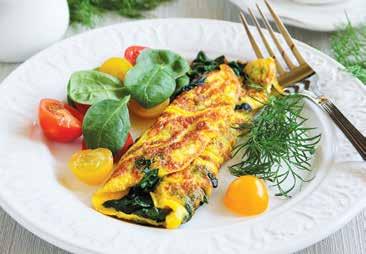

10 eggs 1 cup chopped artichoke hearts, packed in water 1 large tomato 4 oz fresh baby spinach, chopped 2 cloves garlic, minced ⅔ cup green olives, chopped ½ tsp dried thyme ½ tsp dried oregano Sea salt and freshly ground black pepper 2 Tbsp coconut oil In a large bowl, whisk together all the ingredients except the oil. Heat the oil in a large skillet over medium high heat. Pour the mixture into the skillet. After 1 to 2 minutes, when the omelet has begun to brown, fold it in half and continue to cook for another 1 to 2 minutes on each side until the center is cooked through. Serve immediately.
CURRY CHICKEN SALAD
YIELD: 4 SERVINGS
4 organic, boneless, chicken breasts 1 to 2 bay leaves ½ cup chopped celery ½ cup chopped walnuts ⅔ cup avocado mayonnaise 2 tsp gluten-free Dijon mustard 1 tsp curry powder Sea salt and black pepper Wash and pat dry the chicken. Add water to a steamer (per manufacturer’s instructions) and add bay leaves. Place the chicken in the steamer basket and steam for 45 to 50 minutes. Do not overcook. Allow to cool, then shred or chop. In a large bowl, combine the chicken, celery, walnuts, mayonnaise, mustard, and curry. Blend well with a fork, taste and season with salt and pepper. Add the salad greens to plates and mound with the chicken salad. Garnish with parsley, avocado and pomegranate arils (seeds). If desired, drizzle salad greens with juice of a lemon and extra-virgin olive oil.
